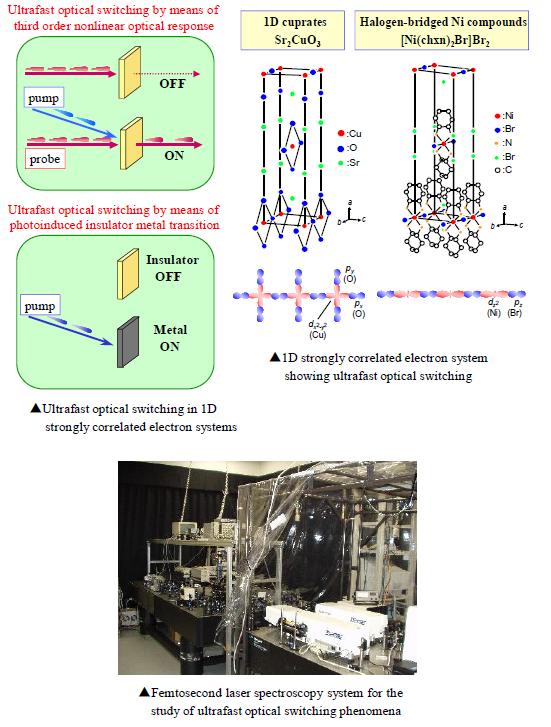Department of Advanced Materials Science, Graduate School of Frontier Sciences, The University of Tokyo
Research
In correlated electron systems governed by strong Coulomb repulsion among electrons as well as low-dimensional electron systems in which electron motion is confined in one or two-dimensional space, there are unique possibilities for the emergence of new optical functionalities, which would be beyond the properties of conventional semiconductors.
In our laboratory, we employ a variety of ultrafast laser spectroscopies covering a range from the visible region to the terahertz region on the studies of correlated electron systems and low-dimensional materials, such as transition metal oxides, transition metal complexes, organic molecular compounds, and carbon nanotubes. By those advanced laser spectroscopies, we explore new optical functionalities originating from strong electron correlations and/or low dimensionalities, and aim to clarify mechanisms of observed phenomena and design new materials. Our main themes are as follows.
1. Explorations of ultrafast photoinduced insulator-metal transition phenomena
2. Realizations of ultrafast photocontrols of magnetisms, dielectrics, and structures
3. Explorations of gigantic third-order nonlinear optical responses and designs of ultrafast switching devices
4. Developments of laser spectroscopy systems with high time-resolutions
5. Developments of spatial- and time-resolved terahertz spectroscopy systems
Left figure shows the schematics of the basic concepts of new optical functionalities we recently found in correlated electron systems. In right figure, we show the crystal structures of one-dimensional copper oxides and halogen-bridged Ni complexes, which exhibit the gigantic third-order nonlinear optical responses. With use of this functionality, we can realize the ultrafast On/Off switches controlled by light, as schematically shown in the upper panel of left figure. Furthermore, the ultrafast conversion from insulating to metallic states with a time scale of 〜10 fs was achieved in halogen-bridged Ni complexes by irradiating a femtosecond laser pulse (lower panel of left figure). It is expected that such nonlinear optical response and photo-switching phenomenon based on the insulator-metal transition will be used for the ultrafast optical communication technology in future.



